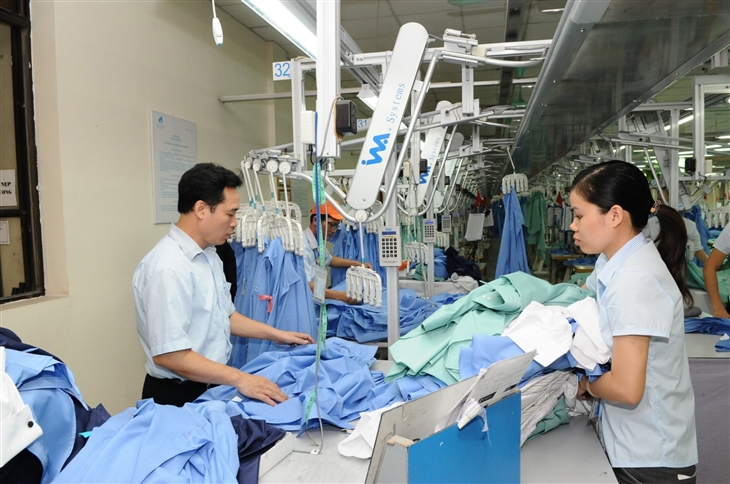Niche markets, opportunities for textile, garment exports
Sunday, September 3,2023
AsemconnectVietnam - Niche markets such as the Middle East, Africa, Canada or markets without a free trade agreement are offering new opportunities for Vietnamese textile and garment exporters in the context of traditional export markets’ sharp decline.
Truong Van Cam, Vice Chairman of the Vietnam Textile and Apparel Association (VITAS), said Vietnam exported textiles and garments worth an estimated US$22.8 billion in the first seven months of 2023, US$14.7 billion less than the same period last year. All exports decreased considerably with garment exports declining by 13.2 percent to reach US$17.8 billion, while fabric exports reached US$1.37 billion (down 18 percent); fiber exports amounted to US$2.5 billion (down 20.7 percent); material and accessory exports were US$700 million (down 17 percent); and non-woven fabric exports decreased by 25 percent.
Although the export decrease slowed down from 17.6 percent in the first half of this year to 14.7 percent in the first seven months of 2023, according to the VITAS representative, textile and garment exporters are still facing numerous difficulties due to the lack of orders and decreased export prices.
The geopolitical conflicts, the COVID-19 pandemic, high inflation rate and growing inventories have decreased the world’s demand in 2023 for textiles and garments by 8-10 percent, and Vietnamese textile and garment enterprises are expected to face further difficulties at least until the end of this year or early 2024, with their 2023 exports forecast to reach about US$40 billion, 9-10 percent less than 2022, Cam said.
Eighty-five percent of Vietnamese textiles and garments are exported so their producers are significantly impacted by changes in foreign markets. Textile and garment enterprises need information about markets, rivals and policies of importing countries, especially such big markets as the EU, the US and Japan, Cam said.
Vietnam’s textile and garment industry has yet to take advantage of the Comprehensive and Progressive Agreement for Trans-Pacific Partnership (CPTPP) because of the yarn-forward rule of origin. Vietnam can sign a bilateral free trade agreement with Canada, a CPTPP member, to benefit from the less-than-three-stage rule, or coordinate with ASEAN (the Association of Southeast Asian Nations) countries to speed up the negotiation of a free trade agreement with Canada in order to help domestic enterprises accelerate exports to this market.
Vu Ba Phu, Head of the Ministry of Industry and Trade’s Vietnam Trade Promotion Agency (VIETRADE), said Vietnamese textile and garment enterprises are dependent on a number of traditional and large markets, including the US and EU. It is important for them to shift to other markets such as China, Canada, the Middle East and Africa, as traditional and large markets have experienced high inventories and a falling demand, Phu said.
Participation in international trade fairs and exhibitions remains important for export promotion.
Vietnamese trade offices overseas need to work with the Ministry of Industry and Trade’s units to propose solutions to cope with and remove technical barriers faced by Vietnamese exports in general and textile and garment exports in particular.
Source: Ven.vn
Coffee exports reached 1.2 million tonnes in first 8 months of 2023
FDI in Vietnam totaled over 18 billion USD in first 8 months of 2023
Vietnam’s exports and imports of goods increased in August
Textile, garment exports to Canada to likely reach US$2 billion
Over 416 million USD invested abroad in 8 months
Infrastructure projects help attract industrial investments to Mekong Delta: Savills Vietnam
DAILY: Vietnamese coffee prices increased by 700 VND on August 31
Reference exchange rate down 1 VND
Export of agro-forestry-aquatic products down 9.5% in eight months
Vietnam’s coconut export to reach 1 billion USD in 2025: insider
Vietnam’s seafood exports and imports in first 7 months of 2023
Vietnam - Singapore's 11th largest trading partner
Major export commodity groups to South Korea in first 7 months of 2023
10 commodity groups with export turnover decreased by more than 500 million USD in 7 months

Plan on implementing national strategy on climate change ...
Actively and effectively adapting, reducing vulnerability, loss and damage due to climate change; reduce greenhouse gas emissions ...Scheme on attracting, restructuring and improving quality ...
Urban development plan of Binh Phuoc province in a period ...
Plan on implementing Decision No. 327/QD-TTG dated March ...

Hung Kings Temple Festival 2023 kicks off
The Hung Kings Temple Festival 2023 and the Culture and Tourism Week of Ancestral Land 2023 kicked off in the northern province of Phu Tho ...Vietnam trounce Palestine at AFC U-17 Women's Asian ...
Phu Tho: Festival honours UNESCO intangible cultural ...
Saigontourist Group Food and Culture Festival 2023 opens
Vietnam’s top swimmer Huy Hoang to hold Vietnamese flag at ...



